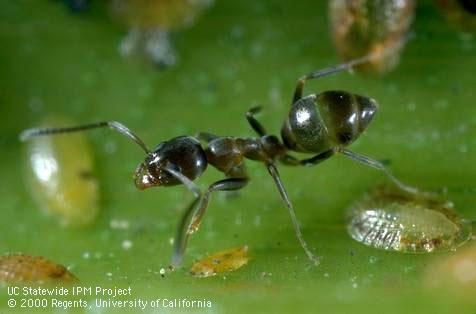Dr. Hoddle presented about how to monitor and manage Argentine ant in citrus orchards with liquid baiting systems and discussed why ant management has such strong benefits for the suppression of sap-sucking pests by natural enemies. This information is critical for PCAs and growers to better understand why managing Argentine ant is important. (Presentation slides in the PDF format)
From: https://www2.ipm.ucanr.edu/agriculture/citrus/Ants/
There are numerous species of ants present in citrus orchards, however, the most common are the Argentine ant (southern and coastal California), the native gray ant (San Joaquin Valley) and the southern fire ant (statewide). The red imported fire ant has been found in Southern California, but is not yet established in citrus orchards. It is important to identify the primary ant species in the orchard, because management tactics depend on which ant species is present.
The Argentine ant, is a small, uniformly deep brown ant. Worker ants travel in characteristic trails on trees, the ground, or irrigation lines and build their nests underground. Ant populations peak in mid-summer through early fall.
The southern fire ant is light reddish brown with a black abdomen. These ants build nests of loose mounds or craters near bases of trees, do not aggregate in colonies as large as those of the Argentine ant, and will sting and bite.
Native gray ants are gray and considerably larger than the other two species. They nest in topsoil or under rocks and debris and move in irregular patterns. In contrast to Argentine and fire ants, the native gray ant is solitary and its importance in disrupting biological control is often underestimated.
Red imported fire ant is new to California and can make large, dome-shaped mounds. They feed on almost any plant or animal material.
Damage
Most ant species feed on honeydew excreted by various soft scales, mealybugs, cottony cushion scales, whiteflies, psyllids, and aphids. As part of this relationship, they protect these pest insects from their natural enemies, thus interrupting biological control. They also protect some non honeydew-producing pests, such as California red scales.
Argentine and native gray ants are the most common ant species that aggressively protect pest insects. In addition, Argentine ants and fire ants can plug up irrigation sprinklers. Fire ants directly damage citrus by chewing twigs and tender bark of newly planted trees; they also sting people working in the orchard and may cause allergic reactions.
No effective natural enemies of ants are known.
Cultural Control
Skirt prune trees, i.e., remove branches within 12 to 30 inches of the ground, and apply sticky material to the trunk to prevent access to the trees by ants. Use polybutenes, as oil-based materials may cause phytotoxicity and should not be used.
The application of sticky polybutene materials directly to the trunk of citrus trees can cause bark cracking, especially if multiple applications are applied to the same area of the trunk, the area is exposed to sunlight (topworked trees), or both. The sticky material can be applied on top of a tree wrap or a base layer of latex paint. Young trees, which have a very thin cambium layer, are most susceptible to damage.
Sticky material should last from 1 to 4 months and will also prevent the access by Fuller rose beetles. If the sticky material contains tribasic copper sulfate, it will also control brown garden snails. The persistence of sticky material can be increased by applying it higher above the ground to reduce dust and dirt contamination and to decrease irrigation wash-off.
Baits
Argentine ant adults are liquid-feeding only and have physical digestive "blocks" in the mouth and gut to prevent them from swallowing and digesting solid food particles. They may bring back solid food to the colony to feed the brood (but solid-food digestion not been confirmed in Argentine ant brood), or harvest the bodily fluids inside of insect prey/moisture in food items. Dry insects or food items are of little use to them, even though they may pick these things up. Feeding studies have shown ants feed several times faster on liquids than gels and gels than solids. This faster feeding resulted in much higher toxicity with liquid. Gel was intermediate, and solids provided the lowest control.
Put out bait in the shade to increase feeding and overall kill. You do not need to obscure it. The soil temperature and moisture are going to be more moderate in the shade, particularly under the canopy. This is the environment the ants will prefer to feed in. There will be less evaporative loss in the shade, as well. Sometimes when the toxins become too concentrated they are less attractive to the ants. The other issue is that many toxins (like borax products) may photodegrade at a faster rate in direct sunlight.
